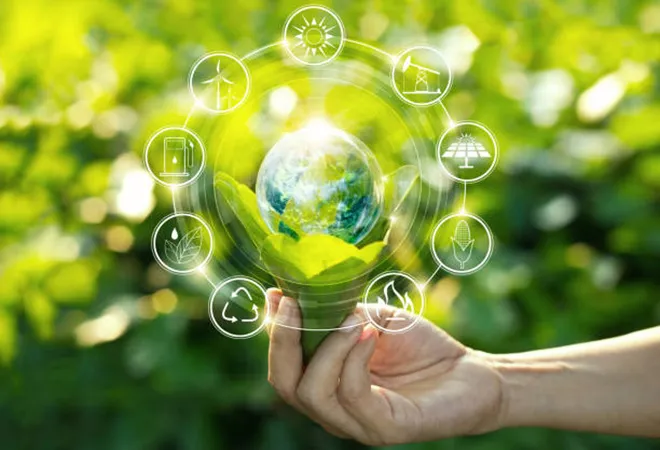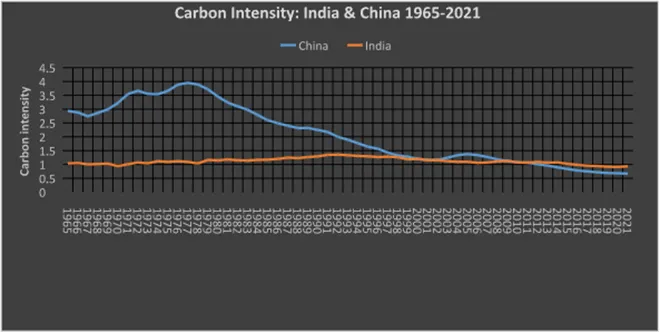-
CENTRES
Progammes & Centres
Location
While the recent Energy Conservation Amendment Act 2022 sought to reduce India’s carbon intensity and increase energy conservation, it might not be consistent with its industrial policies
 This article is part of the series Comprehensive Energy Monitor: India and the World
This article is part of the series Comprehensive Energy Monitor: India and the World
Energy intensity is a measure to assess the energy efficiency of a particular economy. It is calculated by taking the ratio of energy use (or energy supply) to gross domestic product (GDP), indicating how well the economy converts energy into monetary output. The smaller the energy intensity ratio is, the lower the energy intensity of a particular nation. Low energy intensity represents the efficient use of energy to generate wealth. Carbon intensity is the carbon emission per unit of energy consumed, which reflects the energy mix used to produce wealth. Low carbon intensity signals either low energy consumption (as in the case of poor households/regions/countries) or an economy that consists of high efficiency in energy use or the dominance of low energy activities such as services). In the light of the above, key provisions of the amended act, barring the power given to the central government to mandate energy efficiency standards on devices, focus on reducing carbon intensity rather than on energy conservation or energy efficiency. Essentially, the energy conservation amendment act is used as a vehicle to meet India’s commitment to reduce the carbon emissions intensity of its GDP (gross domestic product) by 45 percent by 2030, from the 2005 level and achieve about 50 percent cumulative electric power installed capacity from non-fossil fuel-based energy resources by 2030 as communicated in its updated nationally determined contribution (NDC).Expansion investment, by definition, expanded the existing capital stock (such as investment in new power generation capacity), enabling increased production levels and increased total energy use, but at a lower level of energy intensity, assuming new capital is more efficient than existing capital.
Between 1990 and 2019, India’s GDP increased more than six-fold, whilst total final energy consumption increased only by a factor of 2.5 (or GDP grew more than twice as fast as energy consumption). This means that India has required less energy to produce an additional unit of economic output over the years. According to government data, India’s CO2 intensity in 2021 was 28 percent lower than the CO2 intensity in 2005. Structural shift away from traditional biomass (firewood, animal dung etc.) as fuel for cooking in Indian households was one of the key drivers of the increase in energy use efficiency. Although millions of Indian households continue to use biomass as their primary fuel for cooking, the share of energy derived from biomass in final energy consumption fell from 42 percent in 1990 to 18 percent in 2019 as households shifted to LPG (liquid petroleum gas) or piped natural gas. The switch from biomass with a very low conversion efficiency (5-10 percent) to high efficiency petroleum-based fuels enabled economic activity growth without commensurate growth in energy consumption. The decline in the share of biomass in India’s energy basket was responsible for 60 percent of the decline in energy intensity. The second driver of improvement in energy intensity was the shift in the structural composition of growth in favour of the services sector, which is less energy intensive than growth dominated by industry. Nearly 90 percent of total value‐added growth in India in the period 1990‐2017 came from sectors in the lowest energy intensity category, including large retail service sectors, business, and financial services. The third driver of the improvement in energy intensity in India was technical efficiency of production and consumption processes. Relatively high energy prices, price sensitivity amongst consumers, and a young capital stock contributed to technical efficiency in energy use. The general wave of economic efficiency improvements that occurred after liberalisation in the early 1990s also contributed to the improvement in technical efficiency in manufacturing processes in India.Structural shift away from traditional biomass (firewood, animal dung etc.) as fuel for cooking in Indian households was one of the key drivers of the increase in energy use efficiency.
The fourth factor, a rather perverse one, is India’s slow pace of industrialisation and the consequent low per person energy consumption that has a limited energy intensity and carbon intensity. In 2019-20 (pre-covid), India generated 1381 terawatt hours (TWh) of electricity. Divided equally between a population of over 1.395 billion, it amounts to a per person electricity consumption of just under 1000 kilowatt hours (kWh) which is lower than the world average of 3316 kWh in 2020. India is the only country in the G20 group that has energy consumption below the world average. Low energy consumption, or more accurately, low incomes that limit energy consumption at the household level, has meant poor quality of life for millions of households, especially in rural India. This, in turn, has contributed to lower energy and carbon intensity.Divided equally between a population of over 1.395 billion, it amounts to a per person electricity consumption of just under 1000 kilowatt hours (kWh) which is lower than the world average of 3316 kWh in 2020.

The views expressed above belong to the author(s). ORF research and analyses now available on Telegram! Click here to access our curated content — blogs, longforms and interviews.

Akhilesh Sati is a Programme Manager working under ORFs Energy Initiative for more than fifteen years. With Statistics as academic background his core area of ...
Read More +
Ms Powell has been with the ORF Centre for Resources Management for over eight years working on policy issues in Energy and Climate Change. Her ...
Read More +
Vinod Kumar, Assistant Manager, Energy and Climate Change Content Development of the Energy News Monitor Energy and Climate Change. Member of the Energy News Monitor production ...
Read More +